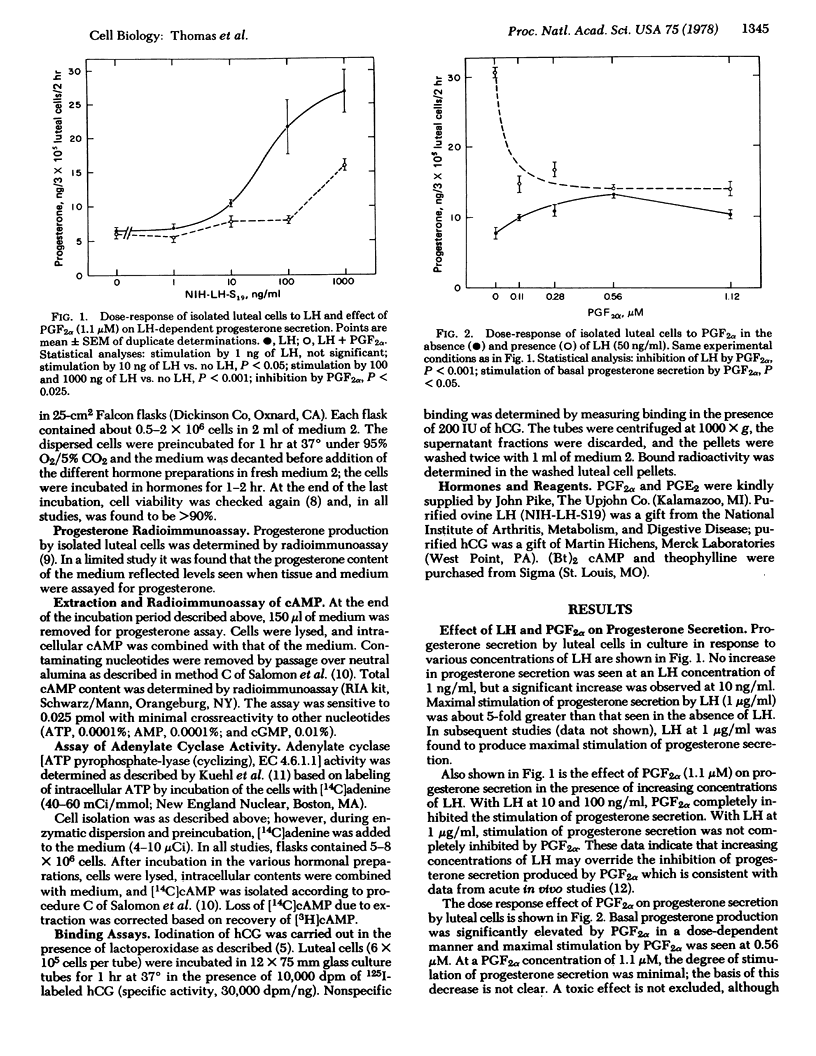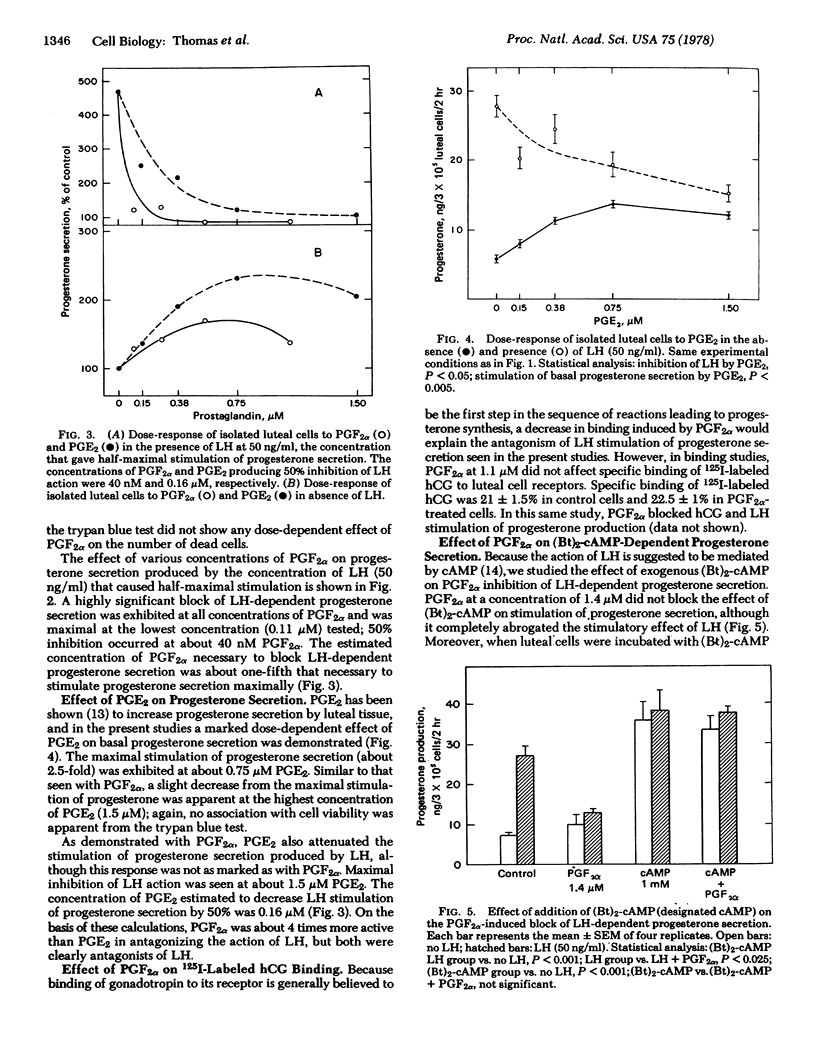Abstract
A reproducible method for dissociation and culture of rat luteal cells is described. The concentration of LH required to produce half-maximal stimulation of progesterone secretion was 50 ng/ml. The effects of prostaglandin E2 (PGE2) and prostaglandin F2α (PGF2α) on basal and luteinizing hormone (LH)-stimulated progesterone production were examined. Both prostaglandins stimulated basal progesterone production but PGE2 was about twice as active, showing a 2-fold maximal stimulation at 0.75 μM. When either prostaglandin was incubated simultaneously with LH, a dose-dependent inhibition of progesterone secretion occurred; PGF2α was 4 times more active than PGE2, showing 50% inhibition at a concentration of 40 × nM. Thus, both prostaglandins are more active as antagonists than as agonists of LH with respect to progesterone secretion. PGF2α also inhibited LH-stimulated adenylate cyclase activity and cyclic AMP accumulation. The block in progesterone secretion was reversed by addition of dibutyryl cyclic AMP (1 mM) but not by theophylline (5 mM) alone. These data and the finding that PGF2α did not affect the specific binding activity of the LH receptor in intact luteal cells indicate that the rapid action of prostaglandins in luteal cells is due to a block of LH-dependent production of cyclic AMP which results in a decrease in progesterone secretion.
Keywords: prostaglandin F2α, luteolysis, gonadotropin receptor, adenylate cyclase
Full text
PDF




Selected References
These references are in PubMed. This may not be the complete list of references from this article.
- Behrman H. R., Hichens M. Rapid block of gonadotropin uptake by corpora lutea in vivo induced by prostaglandin F2alpha. Prostaglandins. 1976 Jul;12(1):83–95. doi: 10.1016/s0090-6980(76)80008-1. [DOI] [PubMed] [Google Scholar]
- Behrman H., Yoshinaga K., Greep R. Extraluteal effects of prostaglandins. Ann N Y Acad Sci. 1971 Apr 30;180:426–435. doi: 10.1111/j.1749-6632.1971.tb53210.x. [DOI] [PubMed] [Google Scholar]
- Grinwich D. L., Ham E. A., Hichens M., Behrman H. R. Binding of human chorionic gonadotropin and response of cyclic nucleotides to luteinizing hormone in luteal tissue from rats treated with prostaglandin F2alpha. Endocrinology. 1976 Jan;98(1):146–150. doi: 10.1210/endo-98-1-146. [DOI] [PubMed] [Google Scholar]
- Grinwich D. L., Hichens M., Behrman H. R. Control of the LH receptor by prolactin and prostaglandin F2alpha in rat corpora lutea. Biol Reprod. 1976 Mar;14(2):212–218. doi: 10.1095/biolreprod14.2.212. [DOI] [PubMed] [Google Scholar]
- Hammarström S., Powell W. S., Kyldén U., Samuelsson B. Some properties of a prostaglandin F2alpha receptor in corpora lutea. Adv Prostaglandin Thromboxane Res. 1976;1:235–246. [PubMed] [Google Scholar]
- Henderson K. M., McNatty K. P. A possible interrelationship between gonadotrophin stimulation and prostaglandin F2alpha inhibition of steroidogenesis by granulosa-luteal cells in vitro. J Endocrinol. 1977 Apr;73(1):71–78. doi: 10.1677/joe.0.0730071. [DOI] [PubMed] [Google Scholar]
- Hichens M., Grinwich D. L., Behman H. R. PGF-2 alpha-induced loss of corpus luteum gonadotrophin receptors. Prostaglandins. 1974 Sep 25;7(6):449–458. doi: 10.1016/0090-6980(74)90089-6. [DOI] [PubMed] [Google Scholar]
- Kuehl F. A., Jr, Humes J. L., Tarnoff J., Cirillo V. J., Ham E. A. Prostaglandin receptor site: evidence for an essential role in the action of luteinizing hormone. Science. 1970 Aug 28;169(3948):883–886. doi: 10.1126/science.169.3948.883. [DOI] [PubMed] [Google Scholar]
- Lahav M., Freud A., Lindner H. R. Abrogation by prostaglandin F2alpha of LH-stimulated cyclic AMP accumulation in isolated rat corpora lutea of pregnancy. Biochem Biophys Res Commun. 1976 Feb 23;68(4):1294–1300. doi: 10.1016/0006-291x(76)90337-5. [DOI] [PubMed] [Google Scholar]
- Marsh J. M., Butcher R. W., Savard K., Sutherland E. W. The stimulatory effect of luteinizing hormone on adenosine 3',5'-monophosphate accumulation in corpus luteum slices. J Biol Chem. 1966 Nov 25;241(22):5436–5440. [PubMed] [Google Scholar]
- Marsh J. The effect of prostaglandins on the adenyl cyclase of the bovine corpus luteum. Ann N Y Acad Sci. 1971 Apr 30;180:416–425. doi: 10.1111/j.1749-6632.1971.tb53209.x. [DOI] [PubMed] [Google Scholar]
- McNatty K. P., Henderson K. M., Sawers R. S. Effects of prostaglandin F2alpha and E2 on the production of progesterone by human granulosa cells in tissue culture. J Endocrinol. 1975 Nov;67(2):231–240. doi: 10.1677/joe.0.0670231. [DOI] [PubMed] [Google Scholar]
- Moudgal N. R., Behrman H. R., Greep R. O. Effect of luteinizing hormone antiserum on progesterone and 20 -dihydroprogesterone secretion in the pregnant rat. J Endocrinol. 1972 Mar;52(3):413–418. doi: 10.1677/joe.0.0520413. [DOI] [PubMed] [Google Scholar]
- Salomon Y., Londos C., Rodbell M. A highly sensitive adenylate cyclase assay. Anal Biochem. 1974 Apr;58(2):541–548. doi: 10.1016/0003-2697(74)90222-x. [DOI] [PubMed] [Google Scholar]


